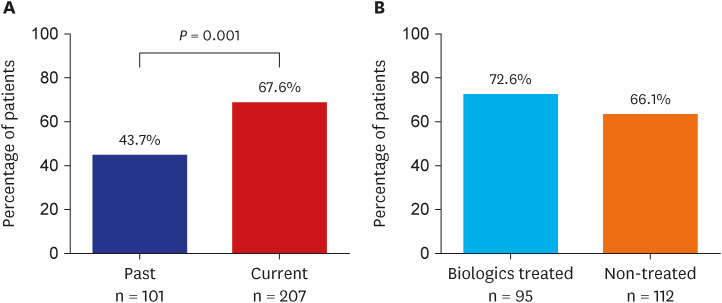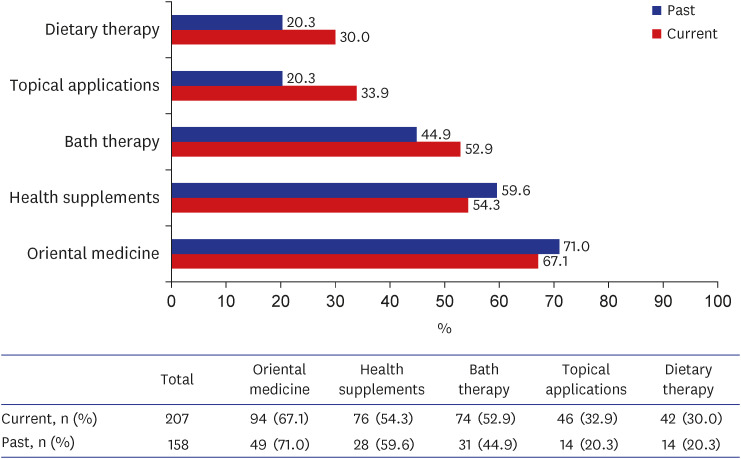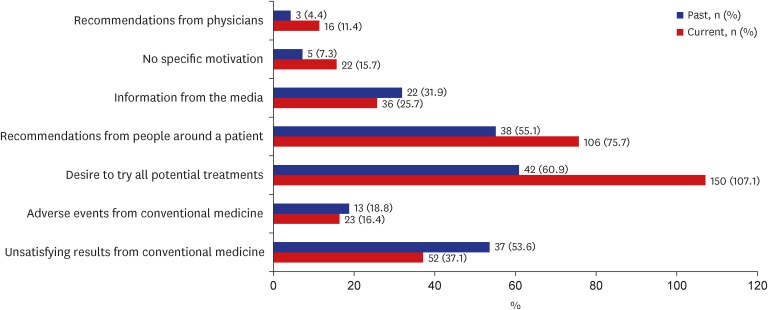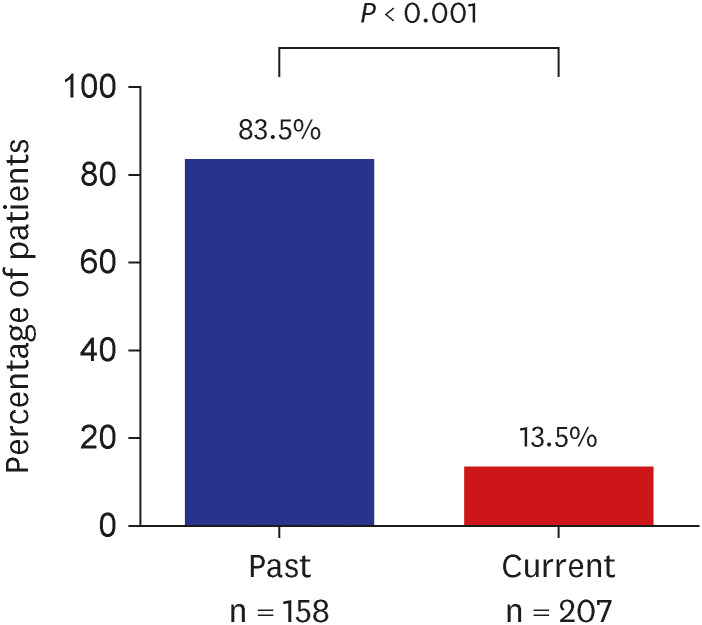J Korean Med Sci.
2023 Jul;38(26):e204. 10.3346/jkms.2023.38.e204.
Change in the Usage of Complementary and Alternative Medicine in the Era of Biologics Among Korean Patients With Psoriasis
- Affiliations
-
- 1Department of Dermatology, School of Medicine, Pusan National University, Busan, Korea
- 2Department of Dermatology, Pusan National University Yangsan Hospital, Yangsan, Korea
- 3Research Institute for Convergence of Biomedical Science and Technology, Pusan National University Yangsan Hospital, Yangsan, Korea
- 4Department of Dermatology, Pusan National University Hospital, Busan, Korea
- 5Biomedical Research Institute, Pusan National University Hospital, Busan, Korea
- KMID: 2544017
- DOI: http://doi.org/10.3346/jkms.2023.38.e204
Abstract
- Background
Patients with long-standing psoriasis who are not treated with conventional medicine seek complementary and alternative medicine (CAM). The biological revolution in the field of psoriasis since the late 2000s has progressed, expecting clearance or almost clearance of the disease. The frequency and type of CAM usage may have changed after these advances. We aimed to investigate changes in CAM use in Korean patients with psoriasis before and after the prevalent use of biologics.
Methods
Patients with psoriasis who visited Pusan National University Hospitals (Busan and Yangsan) between March 2020 and June 2022 were made to complete a face-to-face structured questionnaire. These results were compared with our previous study conducted approximately 10 years ago.
Results
In total, 207 patients were included. Compared with the previous results, the frequency of CAM use (67.6%) increased (P < 0.001). Oriental medicine (67.1%) has most commonly been used, followed by health supplements and bath therapy. The biggest reason for using CAM was “to try all the potential treatments.” Meanwhile, negative concerns about conventional medicine (13.5%) significantly decreased during the 10-year period (P < 0.001).
Conclusion
Although treatment efficacy has increased with biologics development, CAM usage remains prevalent among Korean patients with psoriasis. Therefore, dermatologists need more efforts to improve patients’ understanding of conventional medicine, including biologics.
Keyword
Figure
Reference
-
1. Rousset L, Halioua B. Stress and psoriasis. Int J Dermatol. 2018; 57(10):1165–1172. PMID: 29729012.2. Damevska K, França K, Lotti T, Nikolovska S, Pollozhani N. Complementary and integrative therapies for psoriasis: looking forward. Dermatol Ther. 2018; 31(5):e12627. PMID: 30133906.3. Kim GW, Park JM, Chin HW, Ko HC, Kim MB, Kim JY, et al. Comparative analysis of the use of complementary and alternative medicine by Korean patients with androgenetic alopecia, atopic dermatitis and psoriasis. J Eur Acad Dermatol Venereol. 2013; 27(7):827–835. PMID: 22620682.4. Armstrong AW, Robertson AD, Wu J, Schupp C, Lebwohl MG. Undertreatment, treatment trends, and treatment dissatisfaction among patients with psoriasis and psoriatic arthritis in the United States: findings from the National Psoriasis Foundation surveys, 2003–2011. JAMA Dermatol. 2013; 149(10):1180–1185. PMID: 23945732.5. Kim JY, Lee WJ, Lee SJ, Kim DW, Kim TH, Jun JB, et al. An investigation on the use of complementary and alternative medicine for psoriasis. Korean J Dermatol. 2010; 48(6):494–502.6. Koithan M. Introducing complementary and alternative therapies. J Nurse Pract. 2009; 5(1):18–20. PMID: 20046927.7. Torres-Vega D, Cabanillas F, Rivera N, Sollivan P, Pardo W, Rivera C, et al. Prevalence of complementary/alternative medicine use in cancer patients in a tertiary hospital in Puerto Rico. P R Health Sci J. 2020; 39(4):294–299. PMID: 33320457.8. Dastgheib L, Farahangiz S, Adelpour Z, Salehi A. The prevalence of complementary and alternative medicine use among dermatology outpatients in Shiraz, Iran. J Evid Based Complementary Altern Med. 2017; 22(4):731–735. PMID: 28446027.9. Ock SM, Choi JY, Cha YS, Lee J, Chun MS, Huh CH, et al. The use of complementary and alternative medicine in a general population in South Korea: results from a national survey in 2006. J Korean Med Sci. 2009; 24(1):1–6. PMID: 19270805.
- Full Text Links
- Actions
-
Cited
- CITED
-
- Close
- Share
- Similar articles
-
- Use of Alternative Medicine by Patients with Psoriasis
- Available Alternative Biologics and Disease Groups Influence Biologic Drug Survival in Patients with Psoriasis and Psoriatic Arthritis
- Clinical Features and Treatment Considerations When Switching Biologics in Korean Patients with Severe Psoriasis: A Retrospective Single-Centered Study
- Latent Tuberculosis Infection in Adult Patients with Severe Psoriasis Treated with Biologics at a Single Medical Center
- An Investigation on the Use of Complementary and Alternative Medicine for Psoriasis






